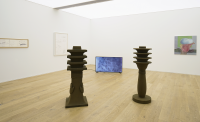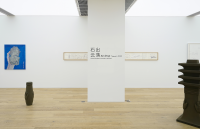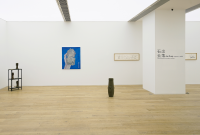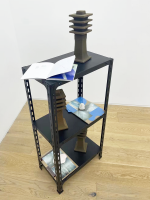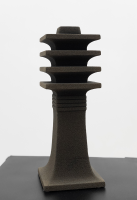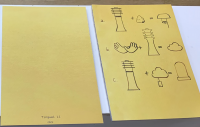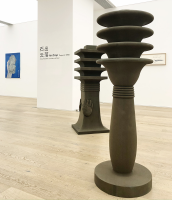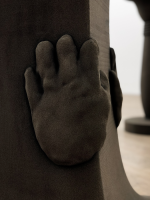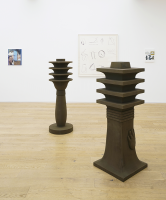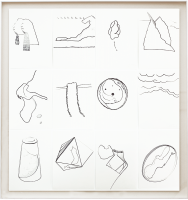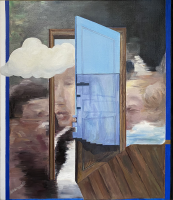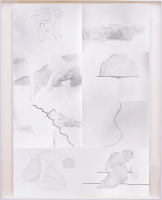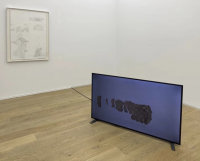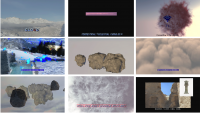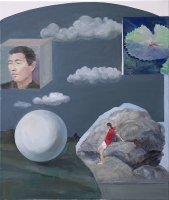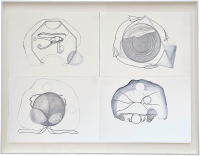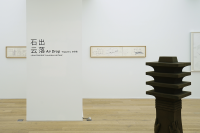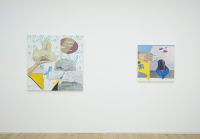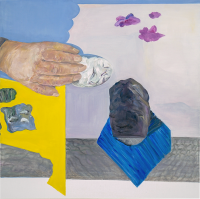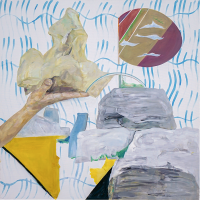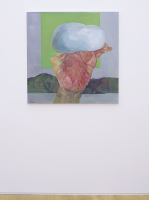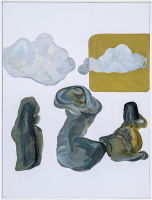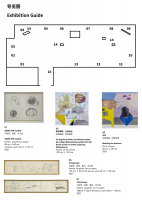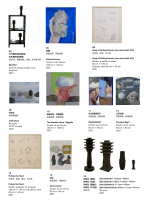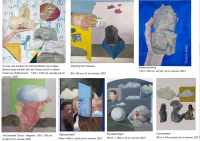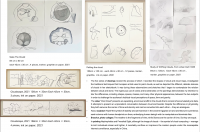巨石为存在在地面上固定且沉重的形态,与云的空间和形态、重量感都正好相反。假设一场云与巨石之间的对话,其实它们互为彼此、相互转换。 我们的什么数据被存储起来了?在现代成为“云端世界”后,我们遗留下的数码废物会形成一个巨大的云中垃圾场。现代城市人被无形大数据的掌控 , 似乎一
直生活在一种噩梦中。
Cloud 在词源上与 clod 相关,《牛津英语词典》报告中,cloud 最初但现在已经过时的意思是岩石或山丘。也许这个词出现在 13 世纪的英语中,最初是从 地球到天体积云的隐喻投影,是大气意义而不是地质意义。 可以带几分公正说“云技术是从煤炭开始的”,而且电子设备的使用会让全球气候变暖。我们通常将社会网络看成是平面的。但实际上社会网络还存在着纵向 深度的维度,在这一维度中,暗物质、煤炭以及稀土资源羁縻着我们。我们很难放弃智能手机和大数据;因为人类在这些物的身上投入太多,所以只会在将来 继续患得患失,受到物质的羁绊。而同时,我们愈加抛弃传统的记录继续相信一个虚拟的、不知所踪的地方储存着我们的记忆和一切数据。
This exhibition features a series of clouds and rocks-themed works that Li produced in 2021, including paintings, 3D prints, video art, and sketches, aiming to stimulate contemplation and conversations regarding time, eternity, nature, and belief in the era of unceasing technological advancement and digitization.
Quarantined in an urban city in Switzerland for three months, the artist witnessed the sense of emptiness reaching its ultimate level. No trace of life could be spotted outside of the window. The clouds in the sky and the boulders on the ground seemed to be the only beings left in the world.
The isolation and physical confinement caused by the global pandemic nevertheless inspired Li to return to the origin of artmaking – on her sketchbook, she delineated the two remaining natural elements she could detect with only pencils. While observing the movements of the clouds in the sky became her daily pleasure, she had gradually been accustomed to the routine that traditional studio artists employed to produce art.
In the late nineteenth century, the British art critic and philosopher John Ruskin delivered a series of lectures at the London Institution, in which he used cloud that often appeared in weather broadcast as a metaphor to reflect upon the “modern anxiety” triggered by the rapid transformation from agriculture civilization to industrial civilization after the second Industrial Revolution and to criticize the loss of faith in the British society.
Through this piece of video art, the artist poses several questions to the audience: Why do humans pursue eternity? Will the data saved in the cloud storage last forever? In the digital society, can data fulfill human’s aspiration for immortality? If, one day, the human society disappears but data manages to remain, is this what we desire?
Djed are three 3d printed sculptures in this solo show. Two disproportional hands are gently attached to the sand column of the 3D-printed sculptures, as if they are piously holding a sacred object and praying for good fortune. Originally Djed is the representation of the spine of Osiris, the God of Underworld in ancient Egyptian mythology, it later evolved into a symbol of stability and was often used as an amulet for both the the living and dead.
The sand and glue applied in the sculpture will gradually oxidize and change its color accordingly, illustrating the aging and fading of substance as time passes by. The the size of enlarged Djed, endowing the portable charm with a sense of monumentality that resembles architecture. Neither a sign of being alive or dead, Djed transcends the concept of mortality. Its stability transcend thousands of years, evaporating and arising from the wish attached to materiality and physicality to the vague, hollow "digital cloud". With the occurrence of digital cloud, the more humans approach to preserve data permanently, the further we depart from physical existence.
"Clod Cloud" attempts to present an unprecedented conversation between cloud and boulders. Despite the difference in physicality, they both serve as the carrier of time and eternity and can be converted into each other – they are analogues.
Human’s unlimited desire for storage and preservation is further illustrated and discussed in Clod Cloud. It presents an expanding, enormous landfill in the clouds that is consist of accumulated junk data. The sounds of ragged breathing and footsteps reverberate at the beginning of the video — the images of a world map, the atmosphere, sky, snow mountains, and unrecognizable clouds and stones overlap on top of each other, unfolding three pieces of conversations between the personified clouds and stones. Hand, which originally serves as the symbol of subjectivity throughout this exhibition, is now compressed and distorted into floating clouds.
The interchangeability between clouds and stones assumes the desire and panic posted by data cyborg, and the ambiguity between the cloud and hand points directly at the origin of human’s pursuit of eternity, even weakening the classical envision of eternity and preservation. Upon the vanish of carnality, what is the meaning of continuously preserving the discarded data on the cloud? Where would be the determination of the data? Why do humans pursue eternity? In the digital society, can data fulfill human’s aspiration for immortality?
